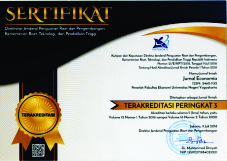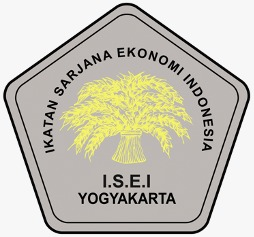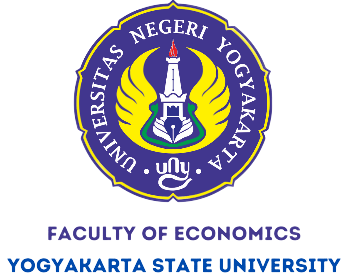The Dynamic Nexus Among Energy Consumption, Economic Growth, and Green Finance on Environmental Quality
Downloads
This study investigates the relationship among energy consumption, economic growth, and green finance on environmental degradation. The Panel Dynamic ARDL-PMG was used to analyze the model in 33 provinces in Indonesia from 2010 to 2022. The result shows that GRDP per capita, Motor Vehicle Volume, and Green Finance significantly positively affect the Environmental Quality Index in the long run. In the short run, GRDP per capita significantly negatively affects the EQI. The findings of this study emphasize that the implementation of Indonesia's energy transition policy must be completed, including a comprehensive transition from upstream to downstream. The transition to a non-fossil fuel energy system must begin by converting fossil fuel power plants to non-fossil fuel power plants. Meanwhile, the government must expand public transportation and encourage electric vehicles through fiscal incentive schemes.
Downloads
Al-Mulali, U., Solarin, S. A., & Ozturk, I. (2016). Investigating the presence of the environmental Kuznets curve (EKC) hypothesis in Kenya: an autoregressive distributed lag (ARDL) approach. Natural Hazards, 80(3), 1729–1747. https://doi.org/10.1007/s11069-015-2050-x
Andreoni, V., & Galmarini, S. (2016). Drivers in CO2 emissions variation: A decomposition analysis for 33 world countries. Energy, 103, 27–37. https://doi.org/10.1016/j.energy.2016.02.096
Aslam, B., Hu, J., Shahab, S., Ahmad, A., Saleem, M., Shah, S. S. A., Javed, M. S., Aslam, M. K., Hussain, S., & Hassan, M. (2021). The nexus of industrialization, GDP per capita and CO2 emission in China. Environmental Technology and Innovation, 23, 101674. https://doi.org/10.1016/j.eti.2021.101674
Aswicahyono, H., Hill, H., & Narjoko, D. (2010). Industrialisation after a deep economic crisis: Indonesia. Journal of Development Studies, 46(6), 1084–1108. https://doi.org/10.1080/00220380903318087
Avotra, A. A. R. N., & Nawaz, A. (2023). Asymmetric impact of transportation on carbon emissions influencing SDGs of climate change. Chemosphere, 324(February), 138301. https://doi.org/10.1016/j.chemosphere.2023.138301
Aydin, M., Degirmenci, T., Gurdal, T., & Yavuz, H. (2023). The role of green innovation in achieving environmental sustainability in European Union countries: Testing the environmental Kuznets curve hypothesis. Gondwana Research, 118, 105–116. https://doi.org/10.1016/j.gr.2023.01.013
Bi, M. (2023). Impact of COVID-19 on environmental regulation and economic growth in China: A Way forward for green economic recovery. Economic Analysis and Policy, 77, 1001–1015. https://doi.org/10.1016/j.eap.2022.12.015
Bilgili, F., Kuşkaya, S., Khan, M., Awan, A., & Türker, O. (2021). The roles of economic growth and health expenditure on CO2 emissions in selected Asian countries: a quantile regression model approach. Environmental Science and Pollution Research, 28(33), 44949–44972. https://doi.org/10.1007/s11356-021-13639-6
Brock, W. A., & Taylor, M. S. (2005). Chapter 28 Economic Growth and the Environment: A Review of Theory and Empirics. In Handbook of Economic Growth (Vol. 1, Issue SUPPL. PART B). Elsevier Masson SAS. https://doi.org/10.1016/S1574-0684(05)01028-2
Chandio, A. A., Jiang, Y., Rauf, A., Mirani, A. A., Shar, R. U., Ahmad, F., & Shehzad, K. (2019). Does energy-growth and environment quality matter for agriculture sector in Pakistan or not? An application of cointegration approach. Energies, 12(10), 1–17. https://doi.org/10.3390/en12101879
Chen, Q., & Xu, X. (2022). China economic quarterly international stabilizing economic growth: Growth target and government expenditure since World War II ☆. China Economic Quarterly International, 2(2), 98–110. https://doi.org/10.1016/j.ceqi.2022.05.003
Chen, Y., & Li, L. (2023). Differential game model of carbon emission reduction decisions with two types of government contracts: Green funding and green technology. Journal of Cleaner Production, 389(January), 135847. https://doi.org/10.1016/j.jclepro.2023.135847
CO2 Emissions from Fuel Combustion 2019. (2019). OECD. https://doi.org/10.1787/2a701673-en
Dance, F. M. (2019). Geological Characterisation of Australia’s First Carbondioxide Storage Site.
Dogan, E., & Aslan, A. (2017). Exploring the relationship among CO2 emissions, real GDP, energy consumption and tourism in the EU and candidate countries: Evidence from panel models robust to heterogeneity and cross-sectional dependence. Renewable and Sustainable Energy Reviews, 77(March), 239–245. https://doi.org/10.1016/j.rser.2017.03.111
Fan, J., Wang, J., Qiu, J., & Li, N. (2023). Stage effects of energy consumption and carbon emissions in the process of urbanization: Evidence from 30 provinces in China. Energy, 276(March). https://doi.org/10.1016/j.energy.2023.127655
Fodha, M., & Zaghdoud, O. (2010). Economic growth and pollutant emissions in Tunisia: An empirical analysis of the environmental Kuznets curve. Energy Policy, 38(2), 1150–1156. https://doi.org/10.1016/j.enpol.2009.11.002
Guo, H., & Jiang, Y. S. (2011). The relationship between CO2 emissions, economic scale, technology, income and population in China. Procedia Environmental Sciences, 11(PART C), 1183–1188. https://doi.org/10.1016/j.proenv.2011.12.178
Hung, N. T. (2023). Green investment, financial development, digitalization and economic sustainability in Vietnam: Evidence from a quantile-on-quantile regression and wavelet coherence. Technological Forecasting and Social Change, 186(PB), 122185. https://doi.org/10.1016/j.techfore.2022.122185
International Energy Agency. (2020). Data and Statistics.
Jernnäs, M., & Linnér, B. O. (2019). A discursive cartography of nationally determined contributions to the Paris climate agreement. Global Environmental Change, 55(January), 73–83. https://doi.org/10.1016/j.gloenvcha.2019.01.006
Juliani, R., Rahmayani, D., Akmala, N. T., & Janah, L. F. (2021). Analisis Kausalitas Pariwisata, Konsumsi Energi Fosil, Pertumbuhan Ekonomi dan Emisi CO2 di Indonesia. Jurnal Dinamika Ekonomi Pembangunan (JDEP), 4(2), 124–139. https://doi.org/https://doi.org/10.14710/jdep.4.2.124-139
Koengkan, M., Fuinhas, J. A., & Santiago, R. (2020). The relationship between CO2 emissions, renewable and non-renewable energy consumption, economic growth, and urbanisation in the Southern Common Market. Journal of Environmental Economics and Policy, 9(4), 383–401. https://doi.org/10.1080/21606544.2019.1702902
Lin, B. Y., & Wang, S. X. (2019). From Catch-Up to Transcend: The Development of Emerging Countries’ Green Economy. Mathematical Problems in Engineering, 2019. https://doi.org/10.1155/2019/1481946
Ma, H. R., Chen, X. Y., Li, J. W., Chang, C. T., Wang, G., Li, H., Wang, X. M., & Li, R. W. (2017). Fe-based amorphous coating with high corrosion and wear resistance. Surface Engineering, 33(1), 56–62. https://doi.org/10.1080/02670844.2016.1176718
Ma, X., & Jiang, Q. (2019). How to balance the trade-offbetween economic development and climate change? Sustainability (Switzerland), 11(6), 1–29. https://doi.org/10.3390/su11061638
Masron, T. A., & Subramaniam, Y. (2019). Does Poverty Cause Environmental Degradation? Evidence from Developing Countries. Journal of Poverty, 23(1), 44–64. https://doi.org/10.1080/10875549.2018.1500969
Meinshausen, M., Meinshausen, N., Hare, W., Raper, S. C. B., Frieler, K., Knutti, R., Frame, D. J., & Allen, M. R. (2009). Greenhouse-gas emission targets for limiting global warming to 2°C. In Nature (Vol. 458, Issue 7242, pp. 1158–1162). https://doi.org/10.1038/nature08017
Mohsin, M., Taghizadeh-Hesary, F., Iqbal, N., & Saydaliev, H. B. (2022). The role of technological progress and renewable energy deployment in green economic growth. Renewable Energy, 190, 777–787. https://doi.org/10.1016/j.renene.2022.03.076
Muhammad Fajar, & Hariyanto. (2021). Pengujian Eksistensi Environmental Kuznets Curve Di Indonesia. Jurnal Lebesgue : Jurnal Ilmiah Pendidikan Matematika, Matematika Dan Statistika, 2(1), 62–68. https://doi.org/10.46306/lb.v2i1.56
Musah, M. (2022). Financial inclusion and environmental sustainability in Ghana: application of the dynamic ARDL estimator. Environmental Science and Pollution Research, 29(40), 60885–60907. https://doi.org/10.1007/s11356-022-19994-2
Nafngiyana, U., Setiawan, & Rahayu, S. P. (2019). Generalized method of moment application in simultaneous dynamic panel data equations for economic growth, CO2 emissions, and health expenditures modelling. IOP Conference Series: Materials Science and Engineering, 546(5). https://doi.org/10.1088/1757-899X/546/5/052045
Osobajo, O. A., Otitoju, A., Otitoju, M. A., & Oke, A. (2020). The impact of energy consumption and economic growth on carbon dioxide emissions. Sustainability (Switzerland), 12(19), 1–16. https://doi.org/10.3390/SU12197965
Ozturk, I., Aslan, A., & Altinoz, B. (2022). Investigating the nexus between CO2 emissions, economic growth, energy consumption and pilgrimage tourism in Saudi Arabia. Economic Research-Ekonomska Istrazivanja , 35(1), 3083–3098. https://doi.org/10.1080/1331677X.2021.1985577
Raheem, I. D., Tiwari, A. K., & Balsalobre-Lorente, D. (2020). The role of ICT and financial development in CO2 emissions and economic growth. Environmental Science and Pollution Research, 27(2), 1912–1922. https://doi.org/10.1007/s11356-019-06590-0
Rahmayani, D., Sugiharti, R. R., Rahman, Y. A., & Vikia, Y. M. (2023). The dynamic linkage among carbon emissions, energy consumption, and economic sustainability in the Asia Pacific. IOP Conference Series: Earth and Environmental Science, 1180(1). https://doi.org/10.1088/1755-1315/1180/1/012028
Razzaq, A., Sharif, A., Ozturk, I., & Afshan, S. (2023). Dynamic and threshold effects of energy transition and environmental governance on green growth in COP26 framework. Renewable and Sustainable Energy Reviews, 179(May 2022), 113296. https://doi.org/10.1016/j.rser.2023.113296
Saboori, B., Sulaiman, J. Bin, & Mohd, S. (2012). An empirical analysis of the environmental kuznets curve for CO2 emissions in Indonesia: The role of energy consumption and foreign trade. International Journal of Economics and Finance, 4(2), 243–251. https://doi.org/10.5539/ijef.v4n2p243
Sasana, H., & Aminata, J. (2019). Energy subsidy, energy consumption, economic growth, and carbon dioxide emission: Indonesian case studies. International Journal of Energy Economics and Policy, 9(2), 117–122.
Shaheen, A., Sheng, J., Arshad, S., Salam, S., & Hafeez, M. (2020). The dynamic linkage between income, energy consumption, urbanization and carbon emissions in pakistan. Polish Journal of Environmental Studies, 29(1), 267–276. https://doi.org/10.15244/pjoes/95033
Stern, D. I. B. T.-R. M. in E. S. and E. S. (2018). The Environmental Kuznets Curve☆. Elsevier. https://doi.org/https://doi.org/10.1016/B978-0-12-409548-9.09278-2
Su, C. W., Umar, M., & Gao, R. (2022). Save the environment, get financing! How China is protecting the environment with green credit policies? Journal of Environmental Management, 323(September), 116178. https://doi.org/10.1016/j.jenvman.2022.116178
Sukono, Subartini, B., Susi, Supian, S., Napitupulu, H., Budiono, R., & Juahir, H. (2019). Modeling of the impact of GDP and human population on CO2 emission by using Cobb-Douglas model and particle swarm optimization. IOP Conference Series: Earth and Environmental Science, 311(1). https://doi.org/10.1088/1755-1315/311/1/012080
Sumargo, B., & Haida, R. N. (2020). Linkages between Economic Growth, Poverty and Environmental Quality in Indonesia. Jurnal Ekonomi Pembangunan: Kajian Masalah Ekonomi Dan Pembangunan, 21(1), 47–59. https://doi.org/10.23917/jep.v21i1.8262
Wang, L. (2022). Research on the dynamic relationship between China’s renewable energy consumption and carbon emissions based on ARDL model. Resources Policy, 77(January), 102764. https://doi.org/10.1016/j.resourpol.2022.102764
Wang, Z., & Jia, X. (2022). Analysis of energy consumption structure on CO2 emission and economic sustainable growth. Energy Reports, 8, 1667–1679. https://doi.org/10.1016/j.egyr.2022.02.296
Widarjono, A. (2009). Ekonometrika: Pengantar dan Aplikasinya. Ekonisia.
Xu, H., Li, Y., Zheng, Y., & Xu, X. (2022). Analysis of spatial associations in the energy–carbon emission efficiency of the transportation industry and its influencing factors: Evidence from China. Environmental Impact Assessment Review, 97(May), 106905. https://doi.org/10.1016/j.eiar.2022.106905
Yingfei, Y., Mengze, Z., Zeyu, L., Ki-Hyung, B., Andriandafiarisoa Ralison Ny Avotra, A., & Nawaz, A. (2022). Green logistics performance and infrastructure on service trade and environment-Measuring firm’s performance and service quality. Journal of King Saud University - Science, 34(1), 101683. https://doi.org/10.1016/j.jksus.2021.101683
Zhang, Q., Gu, B., Zhang, H., & Ji, Q. (2023). Emission reduction mode of China’s provincial transportation sector: Based on “Energy+” carbon efficiency evaluation. Energy Policy, 177(55), 113556. https://doi.org/10.1016/j.enpol.2023.113556
Copyright (c) 2025 Jurnal Economia

This work is licensed under a Creative Commons Attribution 4.0 International License.















